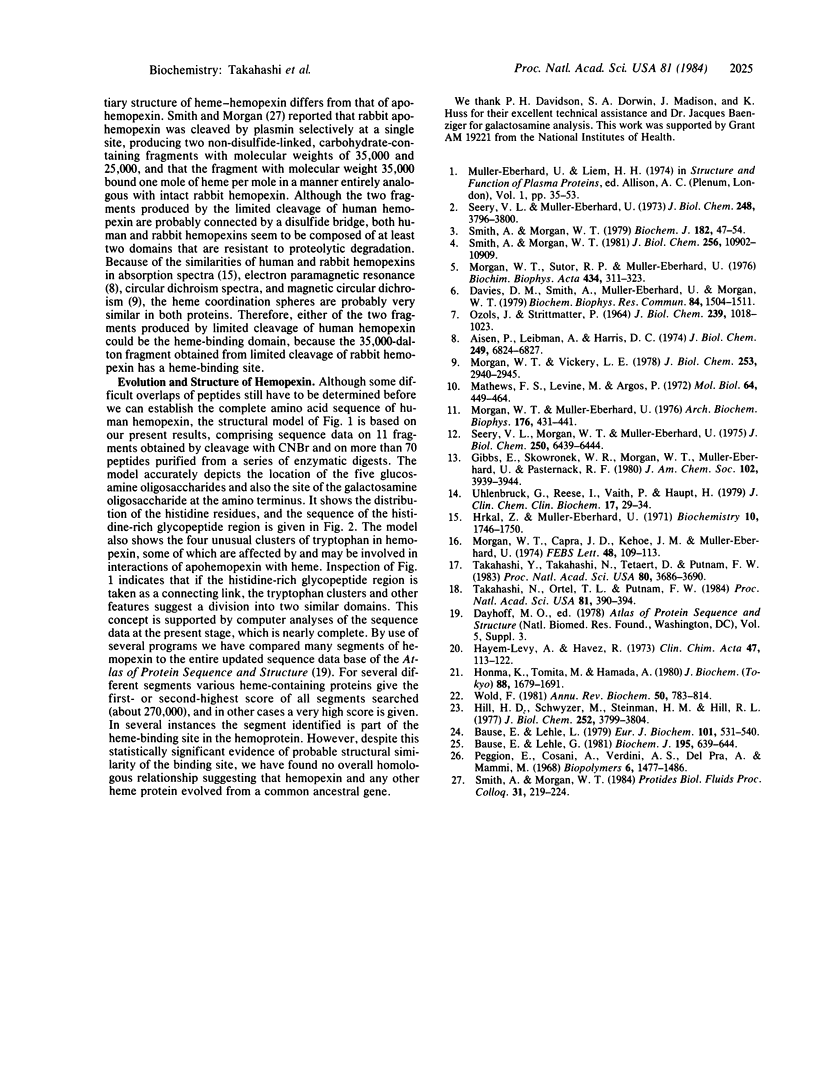Abstract
The primary structure of human hemopexin is being deduced from sequence analysis of a series of peptides obtained from chemical and enzymatic digests of the protein. Human hemopexin consists of about 440 amino acid residues. It has five sites of attachment of glucosamine oligosaccharides at the signal sequence of Asn-X-Thr/Ser. A unique structural feature is the virtual blocking of the amino-terminal threonine residue, which is O-linked to a galactosamine oligosaccharide that has not previously been identified in this protein. The galactosamine oligosaccharide and one glucosamine oligosaccharide are located in the amino-terminal region, three of the glucosamine oligosaccharides are in the middle region, and one glucosamine oligosaccharide is in the carboxyl-terminal region of the protein. Two of the five glucosamine oligosaccharides are present in a histidine-rich sequence of the middle region of the protein, in which the histidines flank beta-turns presumably at the surface of hemopexin. Clusters of tryptophan residues occur in four regions, each of which contains three or four tryptophan residues separated by 0-12 other residues. This clustering is significant because both histidine and tryptophan have been implicated in the binding of heme. A computer analysis did not identify significant matches of human hemopexin to any protein, including cytochromes and other heme-binding proteins, which suggests that the human hemopexin gene evolved from a unique primordial gene differing from those of other heme-binding proteins.
Full text
PDF




Images in this article
Selected References
These references are in PubMed. This may not be the complete list of references from this article.
- Aisen P., Leibman A., Harris D. C., Moss T. Human hemopexin. Preparation and magnetic properties. J Biol Chem. 1974 Nov 10;249(21):6824–6827. [PubMed] [Google Scholar]
- Bause E., Legler G. The role of the hydroxy amino acid in the triplet sequence Asn-Xaa-Thr(Ser) for the N-glycosylation step during glycoprotein biosynthesis. Biochem J. 1981 Jun 1;195(3):639–644. doi: 10.1042/bj1950639. [DOI] [PMC free article] [PubMed] [Google Scholar]
- Bause E., Lehle L. Enzymatic N-glycosylation and O-glycosylation of synthetic peptide acceptors by dolichol-linked sugar derivatives in yeast. Eur J Biochem. 1979 Nov;101(2):531–540. doi: 10.1111/j.1432-1033.1979.tb19748.x. [DOI] [PubMed] [Google Scholar]
- Davies D. M., Smith A., Muller-Eberhard U., Morgan W. T. Hepatic subcellular metabolism of heme from heme-hemopexin: incorporation of iron into ferritin. Biochem Biophys Res Commun. 1979 Dec 28;91(4):1504–1511. doi: 10.1016/0006-291x(79)91235-x. [DOI] [PubMed] [Google Scholar]
- Hayem-Lévy A., Havez R. Isolement et étude de l'hémopexine humaine. Clin Chim Acta. 1973 Aug 30;47(2):113–122. doi: 10.1016/0009-8981(73)90305-7. [DOI] [PubMed] [Google Scholar]
- Hill H. D., Jr, Schwyzer M., Steinman H. M., Hill R. L. Ovine submaxillary mucin. Primary structure and peptide substrates of UDP-N-acetylgalactosamine:mucin transferase. J Biol Chem. 1977 Jun 10;252(11):3799–3804. [PubMed] [Google Scholar]
- Honma K., Tomita M., Hamada A. Amino acid sequence and attachment sites of oligosaccharide units of porcine erythrocyte glycophorin. J Biochem. 1980 Dec;88(6):1679–1691. doi: 10.1093/oxfordjournals.jbchem.a133143. [DOI] [PubMed] [Google Scholar]
- Hrkal Z., Muller-Eberhard U. Partial characterization of the heme-binding serum glycoproteins rabbit and human hemopexin. Biochemistry. 1971 May 11;10(10):1746–1750. doi: 10.1021/bi00786a002. [DOI] [PubMed] [Google Scholar]
- Mathews F. S., Levine M., Argos P. Three-dimensional Fourier synthesis of calf liver cytochrome b 5 at 2-8 A resolution. J Mol Biol. 1972 Mar 14;64(2):449–464. doi: 10.1016/0022-2836(72)90510-4. [DOI] [PubMed] [Google Scholar]
- Morgan W. T., Capra J. D., Kehoe J. M., Muller-Eberhard U. Human and rabbit hemopexins: tryptic peptides and N-terminal sequences. FEBS Lett. 1974 Nov 1;48(1):109–113. doi: 10.1016/0014-5793(74)81074-4. [DOI] [PubMed] [Google Scholar]
- Morgan W. T., Muller-eberhard U. Chemical modification of histidine residues of rabbit hemopexin. Arch Biochem Biophys. 1976 Oct;176(2):431–441. doi: 10.1016/0003-9861(76)90185-5. [DOI] [PubMed] [Google Scholar]
- Morgan W. T., Sutor R. P., Muller-Eberhard U. The aromatic and heme chromophores of rabbit hemopexin. Difference absorption and fluorescence spectra. Biochim Biophys Acta. 1976 Jun 15;434(2):311–323. doi: 10.1016/0005-2795(76)90223-3. [DOI] [PubMed] [Google Scholar]
- Morgan W. T., Vickery L. E. Magnetic and natural circular dichroism of metalloporphyrin complexes of human and rabbit hemopexin. J Biol Chem. 1978 May 10;253(9):2940–2945. [PubMed] [Google Scholar]
- OZOLS J., STRITTMATTER P. THE INTERACTION OF PORPHYRINS AND METALLOPORHYRINS WITH APOCYTOCHROME BETA-5. J Biol Chem. 1964 Apr;239:1018–1023. [PubMed] [Google Scholar]
- Peggion E., Cosani A., Verdini A. S., Del Pra A., Mammi M. Conformational studies on poly-L-tryptophan: circular dichroism and x-ray diffraction studies. Biopolymers. 1968 Oct;6(10):1477–1486. doi: 10.1002/bip.1968.360061010. [DOI] [PubMed] [Google Scholar]
- Seery V. L., Morgan W. T., Muller-Eberhard U. Interaction of rabbit hemopexin with rose bengal and photooxidation of the rose bengal-hemopexin complex. J Biol Chem. 1975 Aug 25;250(16):6439–6444. [PubMed] [Google Scholar]
- Seery V. L., Muller-Eberhard U. Binding of porphyrins to rabbit hemopexin and albumin. J Biol Chem. 1973 Jun 10;248(11):3796–3800. [PubMed] [Google Scholar]
- Smith A., Morgan W. T. Haem transport to the liver by haemopexin. Receptor-mediated uptake with recycling of the protein. Biochem J. 1979 Jul 15;182(1):47–54. doi: 10.1042/bj1820047. [DOI] [PMC free article] [PubMed] [Google Scholar]
- Smith A., Morgan W. T. Hemopexin-mediated transport of heme into isolated rat hepatocytes. J Biol Chem. 1981 Nov 10;256(21):10902–10909. [PubMed] [Google Scholar]
- Takahashi N., Ortel T. L., Putnam F. W. Single-chain structure of human ceruloplasmin: the complete amino acid sequence of the whole molecule. Proc Natl Acad Sci U S A. 1984 Jan;81(2):390–394. doi: 10.1073/pnas.81.2.390. [DOI] [PMC free article] [PubMed] [Google Scholar]
- Takahashi Y., Takahashi N., Tetaert D., Putnam F. W. Complete covalent structure of a human immunoglobulin D: sequence of the lambda light chain. Proc Natl Acad Sci U S A. 1983 Jun;80(12):3686–3690. doi: 10.1073/pnas.80.12.3686. [DOI] [PMC free article] [PubMed] [Google Scholar]
- Uhlenbruck G., Reese I., Vaith P., Haupt H. Immuno-chemical studies on the alkali-labile carbohydrate chains of human serum glycoproteins. J Clin Chem Clin Biochem. 1979 Jan;17(1):29–34. doi: 10.1515/cclm.1979.17.1.29. [DOI] [PubMed] [Google Scholar]
- Wold F. In vivo chemical modification of proteins (post-translational modification). Annu Rev Biochem. 1981;50:783–814. doi: 10.1146/annurev.bi.50.070181.004031. [DOI] [PubMed] [Google Scholar]



